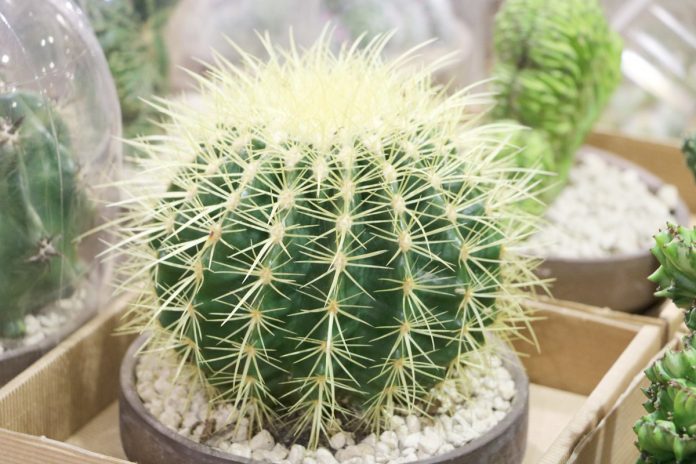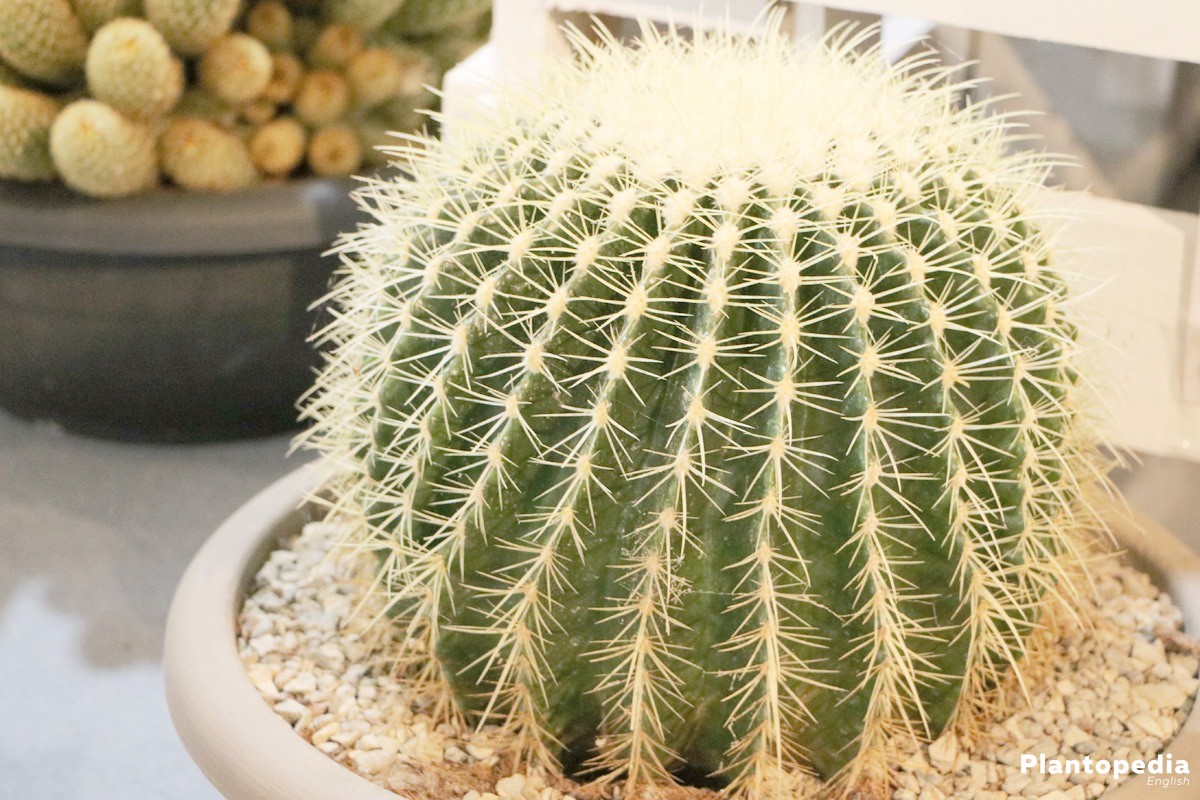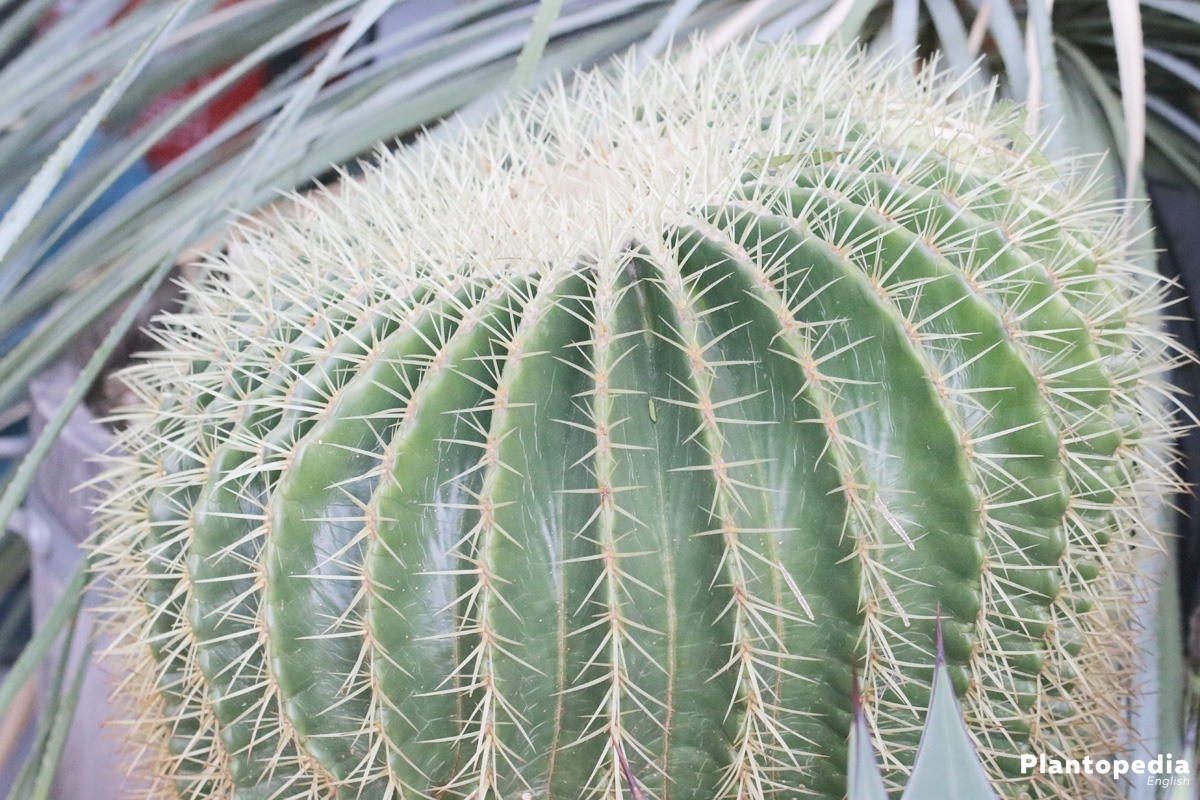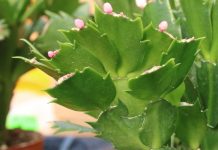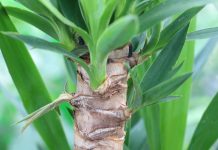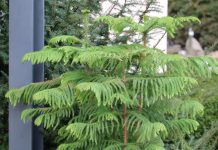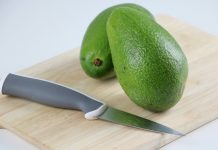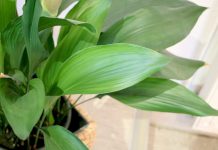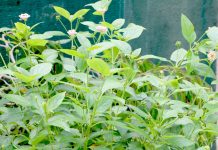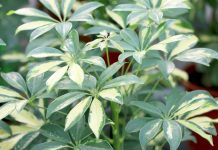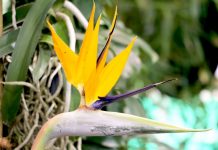Echinocactus grusonii, commonly known as mother-in-law’s cushion, stands out especially due to its golden spines, which form a beautiful contrast to the lush green of the cactus’ body. In addition, this cactus species is exceptionally robust and does not come with many requirements in terms of tending. Learn from these professional care instructions what exactly it is that your cactus needs.
Plant Profile
Contents
- Plant family: cactus family (Cactaceae)
- Genus: Echinocactus
- Common names: mother-in-law’s cushion, golden barrel cactus
- Origin: Mexico
- Growth height: circa 20 centimeters indoors, up to 130 centimeters outdoors
- Yellow flowers, mostly found in older specimens
- Light green, ball-shaped to stout cylindrical shoots
- At risk of extinction
The golden barrel cactus (Echinocactus grusonii) is a fascinating specimen of a plant and a real eye-catcher with its round shape as well as its color highlights. It was elected ‘Cactus of the Year’ in 2008, which is not surprising at all. Besides its impressive appearance, it is also easy to care for, not posing much trouble when it comes to creating ideal living conditions that will allow it to thrive for many years.
Read all about what needs to be considered regarding tending in these detailed care instructions and learn how to grow a golden barrel cactus on your own without going to great lengths.
Care
Tending, wintering, watering, fertilizing as well as propagating like a professional gardener and much more is what you will learn about in these instructions on how to properly take care of a mother-in-law’s cushion.
Location
A mother-in-law’s cushion prefers a bright and sunny spot with warm temperatures of at least 21 degrees centigrade. But it can also handle half-shade and cooler temperatures, although this usually causes it to change its shape of growth from a ball-shape to more of a pillar. Direct sunlight is only manageable for older specimens.
As soon as the sun begins to gain strength, it flourishes splendidly when it is placed outside, but keep in mind that nightly temperatures should not fall below 10 degrees centigrade.
Soil properties
Because a golden barrel cactus (Echinocactus grusonii) can handle dryness much better that too much moisture, it is crucial for the soil to be permeable.
A soil containing sand or clay is ideal. Alternatively, it is an option to add cactus soil to normal flowerbed soil. Moreover, the soil should be rich in humus. Mixing in a bit of compost increases the soil’s nutrient levels.
Substrate
Most suitable is cactus soil, which stores water and simultaneously ensures good permeability so that any excess water can run off.
In case you wish to use a regular substrate, be sure to select one that contains clay and sand as well as perlite for better permeability in order to create living conditions which are about equal to those guaranteed by cactus soil.
Planting time
Echinocactus grusonii can be planted into a tub or a flowerbed as soon as daily and nightly temperatures constantly stay above 10 degrees centigrade. This is usually the case in May or early July at the latest.
Repotting is ideally done in March, when winter dormancy is over and the growth period is just about to begin.
Planting in a flowerbed
Generally, this spiny plant just be given the opportunity to gradually adjust to the unfiltered sunlight by being put outside – planted into a tub or pot – on a daily basis for a period of at least a week. Start with one hour, then increase the time outdoors with every day.
Planted in a bed, Echinocactus grusonii likes its surroundings nice and airy and, therefore, demands considerable space in order to feel at ease. In addition, giving it generous space allows for evenly distributed access to sunlight from all sides.
In the process of planting, there are not many things that need to be kept in mind apart from the soil’s properties:
- size of the planting hole: at least twice as large as the root ball
- distance to adjacent plants: at least 2.5 times the circumference of the cactus
- water drainage: put a drainage made of quartz sand or gravel on top of the soil
- firmly press the soil to avoid cavities
- be generous when watering initially
Keep in mind that only older specimens of mother-in-law’s cushion are able to cope with direct sunlight and midday heat.
Planting in a pot
Potting is done just like planting in a flowerbed. It is important to choose an adequate soil and not to forget the drainage.
Repotting means utter stress to the ‘Cactus of the Year 2008’ (Echinocactus grusonii). For that reason, it should only be repotted when a spot on the terrace or balcony is awaiting it or if the planting container becomes too small. The latter can be noticed by emerging roots that either squeeze their way through the pot’s drainage hole or become visible at the surface.
When repotting, the substrate is to be removed to a large proportion from the roots. Choose a shallow pot with a circumference of about three centimeters more than the old one. It should not be too large, because this could promote root rot.
Watering
To ensure proper watering, stick to the following instructions:
- water moderately from May to September
- water only when the soil’s surface can be dented less than two centimeters deep
- beginning in October, gradually reduce the amount of water in preparation of the coming winter dormancy
- between November and February, the amount of water given needs to be adjusted according to the reduced demand for water
- the golden barrel cactus is able to handle longer periods of dryness very well
Fertilizing
Read below what to keep in mind in order to provide Echinocactus grusonii with sufficient nutrients and minerals by fertilizing it.
- from May to September, every four weeks a cactus fertilizer is given
- if it was repotted in the same year, give a mild product with a rather low concentration
- no fertilizing during the first two months after repotting
- if the mother-in-law’s cushion has been in the same old soil for a long time, a higher concentration of fertilizer is advisable
- in a flowerbed, a bit of compost should be folded in every four weeks
- no fertilizing between October and April
Pruning
A golden barrel cactus (Echinocactus grusonii) is not pruned. The only reason for employing a sharp knife or scissors are damaged roots, noticeable during repotting or planting and removal from a bed.
Wintering
Golden barrel cacti (Echinocactus grusonii) undergo a period of winter dormancy between December and February, a time during which growth stagnates. Because they are not hardy, they have to be put indoors where it is warm at the latest by the time outdoor temperatures fall to five degrees centigrade.
Generally, they can be wintered at temperatures around 10 degrees centigrade, though they need less watering the colder their surroundings are. They also tolerate warm room temperatures during wintering. In this case, the need for water increases compared to a cooler spot, but is still well below the amount they require during the growth phase outside of the winter months.
Important for wintering is a well-lit location. In addition, mother-in-law’s cushions should be regularly checked for pest infestation because pests are especially attracted by the kind of warmer, drier air created by radiators.
With older cactus specimens, cool wintering is advisable, because this can have a positive effect on potential flower development in the following year.
Propagation
As a hobby gardener you will want to limit yourself to the easiest method of propagation since procedure and quality expectations for successful propagation through use of a mother cactus require a high level of expertise and skills as well as sensitivity. This is the simplest one.
Sowing
For this purpose it is ideal to use seeding material that is sold by a specialist retailer because it is very difficult to collect seeds from cacti since they flower rather seldom.
Then follow this propagation procedure:
- fill the pot for propagation with special propagation soil
- thoroughly moisten the soil
- distribute the seeds on top of the soil and lightly press down on them
- because these seeds are light germinators, they are not covered with soil
- cover the pot with transparent plastic wrap
- lift the plastic wrap daily for a few minutes
- make sure the soil is constantly kept moist
- optimal temperature for germination: 25 degrees centigrade
- Time required for germination: between three and five days
- optimal location: sunny, but without direct exposure to incoming sunlight
- Roguing: after two cotyledons have developed
- once it has reached a size of about five centimeters in height, it can be transferred into a normal substrate
Diseases
This cactus species (Echinocactus grusonii) is very robust in terms of susceptibility to diseases. Diseases usually occur only as a result of wrong or too well-meant tending, waterlogging being of especially high importance because it quickly leads to root rot in golden barrel cacti.
Root rot
If a cactus is kept too moist and waterlogging develops, the plant quickly reacts with root rot. This is accompanied by a moldy smell that rises up from the soil and the entire body increasingly softens. When this is the case, you should act immediately and lift the plant from the wet soil. Cut off rotten parts of the root and prune highly drenched roots by about a third.
Then let the root ball dry for a few hours and plant it again or put it back into fresh, dry soil. Moisten the soil only ever so slightly and adjust the amount of watering in the future so that it does not exceed the tolerable limit. Also ensure that a drainage is inserted to allow any excess water to run off.
Pests
Within the wide range of pests that infest plants, only three parasites are normally found in golden barrel cacti as they seem to like settling down on this particular cactus. Apart from specific insecticides that can be purchased commercially from specialist retailers, there are also a few household remedies to fight these pests.
Spider mites
Especially during winter, when indoor heating makes for dry air, spider mites are attracted. They usually inhabit the cactus’ green body as well as the shoots and suck their nourishment from these parts. An infestation can be noticed through the white structures that remind of cobwebs and are drawn between the cactus’ spines.
It is important to separate a cactus infested by spider mites from other plants to prevent them from migrating. Generously spray your Echinocactus grusonii with water and cover it completely in a plastic bag which is then sealed airtight. The plastic bag should be permeable to light.
Put the plant in a light, warm spot for about three to four days. Afterwards the spider mites should all have died due to the airtight seal and the high humidity inside the plastic bag.
Mealybugs
Similarly to spider mites, mealybugs also form white coatings, but they usually cover planar surfaces and remind more of a rug than a cobweb. In addition to that, a mother-in-law’s cushion normally takes on an increasingly browner color when infested with mealybugs. This case also calls for immediate isolation from other plants to prevent migration. Combating them is easily done.
Sound rising with water in the shower or with a garden hose destroys the woven cover. Subsequently mix soap suds with a dash of spirit and spray the cactus every other day over a period of seven to eight days with this mixture. Instead of spirit it is also possible to use vinegar.
Greenfly
You can notice small dark brown to black brown dots on the petioles, flowers and leaf surfaces when greenflies have claimed possession of your mother-in-law’s cushion. They seem to be especially fond of young plants, sucking the vital plant juice out of them. This case requires immediate action because greenflies reproduce rapidly.
Chemical treatment with an insecticide commercially sold by specialist retailers usually helps quickly, but it also means a lot of stress for the golden barrel cactus. Therefore, it is advisable to first try a less invasive household remedy which makes further chemical treatment unnecessary in most cases.
Rise the mother-in-law’s cushion with a strong jet of water. For this purpose, put it in a spot where the washed-off greenflies can run off to where they cannot harm other plants anymore. Ideal is a shower or bathtub where they are flushed down the drain. If the infestation has not yet advanced too much, this approach should already solve the problem.
Extensive infestation with greenflies
To deal with a persistent or extensive infestation with greenflies, prepare strong soap suds, just like you would with mealybugs. Most suitable is neutral or curd soap. Add a generous dash of spirit. Spray your Echinocactus grusonii with this mixture on a daily basis. After about three to four days, all greenflies should have died and fallen off.
It is important to immediately isolate an infested cactus from other plants to prevent the greenflies from migrating. You should only end the isolation when you are absolutely sure that no more greenflies are present.
By the way – you can avoid many pest infestations by regularly spraying the golden barrel cactus with water, especially during the periods of indoor heating. The moisture level is thereby increased, which keeps many pests away.
Varieties
The mother-in-law’s cushion is one of six species of the genus Echinocactus that can be purchased nowadays.
The other five species are:
- Echinocactus horizonthalonius
- Echinocactus parryi Engelm
- Echinocactus platyacanthus Link & Otto
- Echinocactus polycephalus
- Echinocactus texensis

